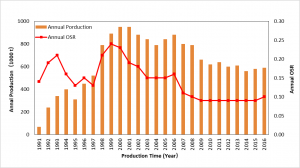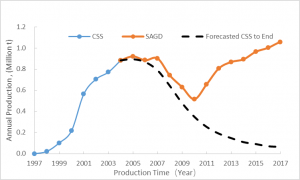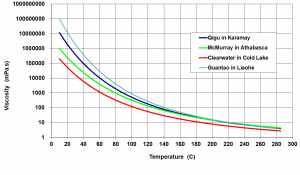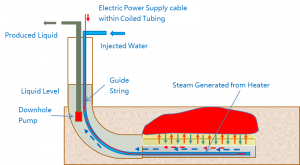A General Review on Status of Heavy Oil Development in China
Qi Jiang
(Southwest Petroleum University, Chengdu, China, and University of Calgary, Calgary, Canada)
Abstract
Most of China’s onshore heavy oil reservoirs are deposited in terrestrial sediments. There are many types of reservoirs, with complicated heterogeneity, mineral components, and a wide range of viscosity. Super heavy oil accounts for the majority of the onshore heavy oil resources. Thermal recovery is the main technical method for the extraction of heavy oil. The recovery technologies used are cyclic steam stimulation (CSS), steam assisted gravity drainage (SAGD), steam flooding (SF), and in-situ combustion (ISC) processes. Cold production with pressure depletion, water flooding and chemical flooding has also been successfully applied for crude oils with lower viscosity at reservoir conditions. At present, annual domestic heavy oil production exceeds 25 million metric tons and has become an important part of total stable domestic crude oil production.
The variation in depth of developed heavy oil reservoirs in China is unique in the world, and ranges from the ultra-shallow depth of less than 200 meters to the ultra-deep depth of more than 5000 meters. Although steam based thermal recovery methods are still the most effective way to increase recovery of heavy oil, the effective depth of using conventional steam injection from surface is limited due to excessive heat loss along the wellbore and from surface pipelines. According to statistics of heavy oil development projects in China, the current CSS technology is mainly used in mid-deep to deep (500 – 2000 meters) heavy oil reservoirs; SAGD is used in shallow (<500 meters) and mid-deep (<800 m) reservoirs; SF is mainly used for reservoirs with a depth of less than 1200 meters; ISC technology is mainly used for conventional heavy oils with a depth of less than 1200 meters. Effective thermal recovery technologies are not yet commercially available for deep and ultra-deep heavy oil reservoirs greater than 2000 meters deep. CSS has been the main contributor to the thermal oil production so far in China however, most of the reservoirs produced by CSS are in late stage development. Production from those mature reservoirs may become uneconomic as a result of low oil productivity and low oil to steam ratio (OSR). It has become urgent to develop effective replacement technologies or follow-up recovery processes to improve the ultimate oil recovery from mature reservoirs produced with CSS.
This article summarizes the current scale of heavy oil development in China, the status of application, the potential of thermal recovery technologies, and the technical challenges faced, in different types of reservoirs. Successful field cases that used SAGD, SF, and ISC to increase oil recovery from reservoirs historically produced with CSS are discussed. To extend the application of thermal recovery to deep and ultra-deep heavy oil reservoirs, the concepts and potentials of downhole steam generation technologies such as downhole electric heating, supercritical water combustion and electromagnetic wave heating are discussed.
Heavy Oil Resources and Current Production
China’s heavy oil resources are abundant. It is estimated that the amount of onshore heavy oil resources is about 20 billion tons [1], which are distributed in more than 70 oil fields in 12 sedimentary basins. The current reserves in commercial development are about 1.4 billion tons. Most of onshore heavy oil reservoirs in China are Mesozoic and Cenozoic terrestrial sediments. A small amount are Paleozoic marine sediments. There are many types of reservoirs and complex geological conditions. Multi-layered reservoirs dominate the reserves, and about 1/3 of the reserves are contained in thick and massive reservoirs. Reservoirs are predominantly characterized by high porosity, high permeability, and unconsolidated sands [2]. Compared with Canada’s oil sands resources, the heavy oils in most of China’s oil reservoirs are generally less mature, have lower asphalt content, a higher resin content, lower density, and a higher viscosity. Reservoir depth is generally less than 2000m. Heavy oil reservoirs with a depth of more than 800m account for about 80% of the proven reserves. About half of the reservoirs have a depth of 1300 – 1700m. In recent years, heavy oil reservoirs have been found in the Tuha oilfield at a depth of 2700 to 3200 m, and ultra-heavy oil reservoirs at a depth of 5000 – 7000 meters have been found in the Tarim Oilfield.
Steam based thermal processes are still the main methods for recovery of onshore heavy oil currently under development. According to the current production scale (Table 1), cyclic steam stimulation (CSS) dominates thermal production (> 70%), followed by steam-assisted gravity drainage (SAGD) and steam flooding (SF). In recent years, in-situ combustion (ISC) was successfully tested in the middle and deep reservoirs of Liaohe Oilfield and in shallow heavy oil reservoirs in Karamay, where it is being commercialized. For crude oils with lower viscosity under reservoir conditions, technologies such as pressure depletion, cold recovery, water flooding and chemical flooding have also been applied. At present, the total domestic heavy oil production exceeds 25 million tons, of which thermal production exceeds 15 million tons.
The major heavy oil production bases include the Liaohe, Karamay, Shengli, Bohai, Tahe, Nanyang, Tuha and Tarim Oilfields (Figure 1). Thermal recovery methods are concentrated in the Liaohe, Karamay, Shengli and Nanyang oil fields. Heavy oil cold production bases include the Bohai and Tahe Oilfields. Table 1 lists the production scale, viscosity, and depth range of the major domestic heavy oil fields.

Table 1, Summary of Production, Viscosity and Depth Range of the Major Domestic Heavy Oil Production Field
| Recovery Method | Annual Production (million Tons)
|
Viscosity (mPa.s) | Depth (metres)
|
|
| Liaohe Oilfield | CSS | 3.3 | 500~300,000 | 550-2000 |
| SAGD | 1.1 | >50,000 | 600-800 | |
| SF | 0.8 | <60000 | 900-1200 | |
| ISC | 0.4 | <10000 | <1600 | |
| other | 0.6 | <250mPa.s | ||
| Karamay Oilfield | CSS | 2.7 | <1,000,000@20 oC | 200-800 |
| SAGD | 1.1 | >1,000,000@20 oC | 180-500 | |
| SF | 0.5 | 3100-5446 20 oC | 185-242 | |
| ISC | 0.1 | 7400-26000 20 oC | 400-600 | |
| Shengli Oilfield
|
CSS accounted for more than 95% | 4.4 | 100-300000 @50 oC | 1100-1200 |
| Tahe Oilfield
|
Cold Production (including water flooding, gas injection etc.) | 3.2 | 50000->1,000,000@50 oC | 5000-7000 |
| Bohai Oilfield
|
Cold Production (including water flooding, chemical flooding, etc.) | >5.0 | 50-2000 | 1200-1500 |
| CSS | 0.3 | 350->10,000 | 1200-1500 |
[Based on presentations from some of oilfield operating companies]
Major Recovery Technologies Currently Used in Field Production
- CSS technology
Field tests of CSS in China can be traced back to the late 1960s and early 1970s. Field tests in the shallow heavy oil reservoirs of the Karamay Oilfield, China, confirmed feasibility of steam injection to recover heavy oil [3]. However, steam generation technology at the time did not include wellbore insulation measures and caused serious casing damage. Most steam condensed to hot water before injection into the formation and did not achieve expected production. In the late 1970s, a single-well CSS test was carried out in a deep well at the Gaosheng reservoir of the Liaohe Oilfield. Due to the lack of wellbore insulation, casing damage and failure led to test failure. In addition, thermal induced expansion of the wellhead led to safety hazards.
In the early 1980s, key technologies for steam injection in deep wells were successfully developed, including surface steam injection boilers, downhole thermal insulation, and thermal packers. The CSS recovery process was successfully tested at the Gaosheng reservoir of the Liaohe Oilfield at a true vertical depth of more than 1600 meters. Subsequent successful CSS pilot tests were also conducted in Karamay Oilfield shallow heavy oil reservoir.
The main mechanisms of steam stimulation include:
- An induced high temperature zone around wellbore which reduces oil viscosity and lifts blockage, thereby increasing reservoir flow capacity to oil;
- Steam and hot fluids injected increase energy in the reservoir available to drive formation fluids;
- Partial thermal cracking of heavy oil reduces the viscosity and improves quality of the produced oil;
- Improved efficiency of solution gas drive and gravity drainage at high temperatures, attributable to free gas and light components released from the heavy oil.
Field evidence indicates that CSS performance is affected by many factors including; rate of steam injection, pressure, temperature, downhole steam quality, reservoir properties, oil viscosity and dissolved gas at formation conditions. China has achieved successful application of CSS in ultra-shallow reservoirs (<300 m), ultra-deep reservoirs (~2000 m), and super viscous heavy oil (>500,000 mPa.s) reservoirs.
Commercial application of CSS technology began in the mid-to-late 1980s. Following completion of the one million-ton-per-year CSS project at the Gaosheng reservoir of the Liaohe Oilfield, commercial development projects have expanded to include different types and depths of heavy oil reservoirs. In the late 1980s annual CSS oil production exceeded 5.0 million tons from the combined production from Liaohe, Karamay and Shengli Oilfields. In the mid-1990s, the annual CSS production exceeded 10 million tons [3]. Reservoir types that utilize CSS recovery include thick block reservoirs, multilayered and thin interlayered reservoirs, reservoirs with top gas, and reservoirs with aquifers, shallow reservoirs at a depth of about 200 meters from the Karamay Oilfield, and deep reservoirs at a depth of more than 1,800 meters in Liaohe Oilfield. The viscosity at initial reservoir conditions ranges from conventional heavy oils of less than 2,000 mPa.s to super heavy oils of more than 500,000 mPa.s. Because CSS is a suitable process for various reservoir heterogeneities, depths, and viscosities, it has a wide range of applications. It is still the main thermal recovery method used in the major oilfields of China, and CSS production accounts for more than 70% of the total thermal recovery output.
The target Lianhua Formation of the Gaosheng reservoir in the Liaohe Oilfield has a vertical depth of more than 1500 meters. Wellbore simulation predicted the quality of injected steam at the sand face to be low (<30%). However, the field test still achieved an initial oil production rate in excess of 650 bbl/d, and an oil to steam ratio (OSR) of greater than 1.0. Analysis indicated that contributing factors to the success of CSS included a large pay thickness (>40 meters) and low crude oil viscosity (<5000 mPa.s) at the initial reservoir temperature (>40 degrees Cº), high initial reservoir pressure (>15 MPa.).
The Guantao Formation in Block Du 84 of the Liaohe Oilfield is classified as a super heavy oil reservoir and is of medium depth (600-800 meters). Commercial development using vertical well CSS has been successfully achieved. Although the oil viscosity at initial reservoir temperature (40 oC) exceeds 500,000 mPa.s, the high permeability reservoir (> 5000 mD), and the large thickness (> 80 m) facilitates an increased steam injection rate and crude oil production capacity. In addition, huge volumes of side, bottom and top waters reduce the rate of reservoir pressure drop during the production stage.
Several pilot tests of CSS were also conducted in the 1970s and 1980s in Canadian oil sands reservoirs, including in sandstone reservoirs of the Athabasca and the fractured carbonate rocks of the Grosmont Formation, where in both, the oil viscosity is more than 500,000 mPa.s at the initial reservoir temperatures. However, most of the Canadian CSS pilot tests failed, or the test results did not achieve results required for commercialization. Compared with the super heavy oil reservoirs of the Du 84 Block in Liaohe Oilfield, the Canadian reservoirs are generally shallow (<500 meters), low pressure (<3.0 MPa), and have a low dissolved gas content. Characteristics which have become recognized as main factors that are not suitable for CSS production. In the Cold Lakes region of Canada, two commercial CSS projects operated by CNRL and Imperial Oil have successfully produced oil with viscosity of about 100,000 mPa.s at reservoir temperature, using horizontal wells and steam injection that is above formation fracture pressure [6].
Due to the limited effective heating radius of CSS (<30 meters), the recovery factor of the CSS process is greatly affected by well spacing [7]. Under given conditions of reservoir and fluid parameters, the oil recovery factor and thermal efficiency are greatly affected by the well spacing. If the distance between wells is too small, then premature communication between wells is prone to occur, and steam channeling between wells results in low thermal efficiency. If the well spacing is too large, then the recovery factor is low. Most of the CSS developed fields in China use vertical wells with well spacing of 70-140 meters. Under the current technical and economic conditions, the average CSS recovery factor is expected to be less than 30%, and in some reservoirs with thick bottom water, CSS recovery factor is less than 20%.
Currently, in developed Chinese reservoirs the main technical issues identified during the CSS phase include:
- Non-uniform flow channels are formed between wells in the early stage of CSS operation. After multiple cycles of steaming, the inter-well steam channeling is severe and occurs in almost all types of oil reservoirs. Examples include the shallow reservoirs (200-350 meters) of Block 9 in Karamay and the mid to deep reservoirs (830-1200 meters) at Block 66 and Block 48 of the Liaohe oilfield. The premature channeling between the wells reduces thermal efficiency for CSS and creates challenges for selection of follow-up processes.
- Low ratio of produced water and high ratio of water storage from injected steam. For example, in the Blocks of Du 66 and Du 48 in the Liaohe oilfield, the rate of water recovery is less than 20% of the rate of injected steam during initial CSS cycles. Most of the condensate injected with the steam remains in the reservoir and forms a high water saturation zone in the near-well region, which reduces the effective heating efficiency of subsequent CSS cycles. Most of the heavy oil reservoirs in China are in very heterogeneous terrestrial sediments. Especially important is the high content of swelling clay montmorillonite type minerals, which cause the clay to expand after steam injection. The swelling clays increase the binding capacity of water and reduce the reservoir permeability.
- Low downhole steam quality due to substantial heat loss from deep wells. Most of the wells in Liaohe and Shengli Oilfields have a vertical depth of more than 1000 meters, and some reservoirs are more than 1500 meters deep. Despite use of insulated tubing, wellbore heat losses are high. Especially in the early stage of CSS operations, the steam injection rate is relatively low, which results in low steam quality at the bottom of the well and reduces the oil-steam ratio (OSR). In contrast to injecting steam above the formation fracture pressure in the Cold Lake region of Canada, the steam injection pressure in Chinese domestic oil fields is lower than the formation fracture pressure. Due to high oil viscosity of crude oil, the injection rate in the early stage of CSS is usually low (<200 t/d), and the thermal efficiency of CSS is low.
- Premature coning of formation water into the production zones. As the pressure of the target layer is decreased, the bottom water and side water breakthrough to the production wells and result in flooding of the oil zones. Depending on the pressure of the water and the volume ratio to the produced oil layer, the pressure of the oil layer after water flooding is maintained at a high level. In addition to a large amount of oil remaining in the production intervals, there is also a large amount of oil remaining above the bottom water after CSS is terminated. Such reservoirs account for a large proportion of Chinese heavy oilfields including the Guantao and Xinglongtai Formations in Block Du 84, the S32 Formation in Block 41, the Lianhua Formation in the Gaosheng Block of the Liaohe Oilfield, and reservoirs such as the Shanjiasi Formation in the Shengli Oilfield.
Most CSS developed reservoirs have entered late stage development. Continued CSS production has low thermal efficiency and increased production costs. Figure 2 shows the decreasing OSR with the increased number of CSS cycles for a typical heavy oil reservoir in the Shengli Oilfield. Figure 3 shows annual CSS oil production and OSR curves in the Karamay Oilfield. It can be seen that after multiple CSS cycles, the OSR is relatively low. Some of the reservoirs have to be abandoned after CSS due to uneconomic OSR. Finding effective replacement or follow-up technologies are key to improving the ultimate oil recovery from those reservoirs.

Figure 2. Typical oil-steam ratio curve of multi-cycle CSS in Shengli Shanjiasi Oilfield

Figure 3. CSS development in Karamay Oilfield, Xinjiang.
- Steam flooding technology
Compared with CSS technology which uses a single well for injection and production, steam flooding (SF) technology uses a pattern of injection and production wells, and has a higher recovery factor. Since 1988, nine SF pilot test areas have been opened in the Liaohe Oilfield, Karamay Oilfield, Shengli and Nanyang Oilfield[3], representing different types of reservoirs, depths, and viscosity ranges. The pilot test area included thick reservoirs with a gas cap; thick reservoirs with edge-bottom water; multi-layered thick reservoirs; multi-layered thin reservoirs; and single sand reservoirs. The viscosity of crude oil is less than 10,000 mPa.s at the majority of the pilot areas, however, viscosity in some test areas exceeded 10,000 mPa.s at reservoir conditions. Except for the Karamay and Nanyang oilfields, where depths of the pilot test areas are shallow (<300 m), the depths of the other test areas are over 800 m.
The reservoirs selected for SF pilot tests were all previously produced using CSS. Because most of the SF pilot areas are deeper than 1,000 meters, the original reservoir pressure exceeded 10 MPa. It is difficult to start effective SF operations at initial reservoir conditions because the specific volume and the latent heat of vaporization of the steam injected at this pressure are low. Reservoir pressure can be reduced through early CSS production until a pressure suitable for converting to SF is reached. For reservoirs with crude oil viscosity of higher than 10,000 mPa.s, early CSS production can increase the temperature of the reservoir, reduce the viscosity of the crude oil, and improve the thermal connectivity of injection-production wells in the steam flooding phase.
In carrying out these SF pilot tests; the following technical challenges were encountered:
- Early steam channeling. Because before SF the reservoirs had undergone CSS production, premature steam channeling to production wells generally occurred. After commencement of SF, injected steam preferentially broke through to the production wells along channels with low flow resistance. For multi-layer reservoirs such as in the Du 66 block, SF can easily break through to the production well along channels with higher water saturation or through a single layer with better permeability, and prematurely reduce SF efficiency.
- In some reservoirs it is difficult to reduce pressure to the level required by SF. For reservoirs with extremely thick bottom water and with large bottom water volume, such as the SF test area of Shengli Shanjiasi Oilfield, the rise of bottom water into the production intervals reduced the thermal efficiency of steam injection, and also made it difficult to reduce reservoir pressure to an ideal level for SF.
- Wellbore heat loss is high, and the bottomhole steam quality is low. Because the average depth of SF pilot test areas in the Liaohe and Shengli Oilfields exceeded 1000 meters, the quality of the steam injected into the reservoir was relatively low (<50%), which lowered SF efficiency.
- Oil viscosity was too high in some pilot areas. The viscosity of crude oil under reservoir conditions in some pilot areas is high (> 10,000 mPa.s), which is at the upper limit of screening criteria for SF. In areas not previously affected by heat from CSS, and due to the high viscosity of the oil, it is difficult to form a steam chamber during SF in areas with high oil saturation. During SF, the main flow channels usually occur in communication channels created from CSS, resulting in low conformance efficiency.
Due to the terrestrial sedimentary characteristics of the reservoirs, the clay content in some test area reservoirs is high (5-10%), which results in low water recovery rates (<40%) during earlier stage of CSS operations. The large amount of condensate left in the reservoir reduces SF thermal efficiency. In order to improve SF performance, a foaming agent and nitrogen were added to the steam to block high water saturation channels and high-efficiency insulated tubing was used to improve the downhole steam quality. Large displacement pumps were also used to increase the production to steam injection ratios. Although a large amount of field data was obtained from these pilot tests that provided a basis for evaluating SF potential in different types of reservoirs, the areas currently extended to commercialization are still small.
At present, the two largest SF blocks in China are: (1) No. 9 Block of Karamay Oilfield and (2) Qi40 Block of Liaohe Oilfield.
The target Formation in No. 9 Block of the Karamay Oilfield has a vertical depth of 185 – 242 meters, an oil viscosity of 3100 – 5500 mPa.s under reservoir conditions, and a pay thickness of 15.5 meters. Since the launch of SF in 1992, No. 9 Block of Karamay Oilfield is the longest and largest SF project in China. Figure 4 shows the annual oil production and OSR curve in No. 9 Block of Karamay Oilfield. The peak annual oil production was 950,000 tons, and the current annual oil output is about 560,000 tons with an OSR of 0.11. The recovery factor from CSS is about 25%, and the incremental oil recovery factor from SF is about 20%, resulting in the current cumulative recovery factor of about 45%.
The target Shahejie Formation in the Qi40 block of the Liaohe Oilfield contains conventional heavy oil with edge and bottom water. The vertical depth of the reservoir is 620 to 1050 meters, and the viscosity of the crude oil at 50oC is 2639mPa.s. The reservoir was first produced with CSS. The SF pilot test was started in 1998 and industrialized expansion began in 2007. The peak annual production reached 670,000 tons, and current production is maintained at more than 400,000 tons annually with an OSR of 0.13. At present, the Qi 40 block has recovered about 50% of OOIP, of which CSS production was 32% and the SF stage recovered 18%. Figure 5 shows the development history and annual production curve of Q40 Block in Liaohe Oilfield.

Figure 4. Annual oil production and oil-steam ratio of steam flooding (SF) in Block No.9 of Karamay Oilfield

Figure 5. Annual oil production of Qi 40 Block of Liaohe Oilfield
- SAGD Technology
The Steam Assisted Gravity Drainage (SAGD) technology, invented by Dr. Butler [8,9] in the late 1970s, began commercialization in the late 1990s after more than 20 years of research and field pilot tests. It has become the most effective technology for the development of heavy oil, especially for development of shallow super heavy oil. Canada is currently the largest SAGD development country in the world, with an annual oil production of more than 50 million tons. The first field test of SAGD in China was carried out in the late 1990s, however commercial application of SAGD began only after 2008. Although it started late, SAGD development has increased rapidly. At present, the total Chinese annual SAGD oil production exceeds 2 million tons, ranking second in the world.
During the SAGD production process, the reservoir is heated by the latent heat of the injected steam, and a continuously expanding steam chamber is formed in the Formation. The heated crude oil and steam condensate flow under the action of gravity to the production well located close to the base of the pay zone and are then produced. One of the most important conditions for successful SAGD application is that steam injected into the bottom of the well must be high quality (>50%). In addition to the continuous vertical permeability of reservoirs suitable for SAGD production, the depth of the reservoir is limited. Under current technical conditions, the application depth of successful SAGD projects is generally less than 800 meters. There are currently two commercial SAGD projects in operation in China.
The first SAGD project was in the Liaohe oilfield. SAGD was used as a follow up process to CSS and has achieved success in production of super heavy oil from the Guantao and Xinglongtai Formations in Block Du 84. CSS production started in Block Du 84 with a well spacing of 70 meters in 2000. Performance deteriorated sharply after multi-cycle production due to high viscosity of the oil (> 500,000 mPa.s at 36oC). Ultimate oil recovery was predicted to be <25% with CSS. In 2003, SAGD was proposed as the follow-up process to CSS. In 2005, a SAGD pilot was implemented. Performance of the SAGD pilot reached technical indicators of the scheme design, and some indicators were exceeded. Industrial scale SAGD production started in 2008. Presently, annual SAGD oil production in Block Du 84 exceeds 1.0 million tons. 15 SAGD well pairs produce more than 100 t/d each, and make important contributions to the Liaohe Oilfield stable production target of 10 million tons annum. Figure 6 is a comparison of the annual SAGD oil production to the predicted annual production of CSS. The cumulative incremental oil from SAGD production has exceeded 8 million tons. At present, the overall recovery of the whole reservoir exceeds 50%, and the recovery in the pilot test area exceeds 70%. Figure 7 compares actual production with predicted production of the original design scheme in the SAGD pilot test area. It shows current production performance is strong. The recovery factor in the central area of the reservoir is expected to exceed 80%. Figure 8 shows growth of the steam chamber from thermal monitoring results and adjacent to some drill core in the reservoir. In the centre of the steam chamber where temperature exceeds 200oC, the remaining oil saturation is about 6%.
In order to improve SAGD thermal efficiency in Block Du 84 of the Liaohe Oilfield, field tests were performed with nitrogen (N2) added to the steam [10,11]. The purpose of injecting N2 with steam was to improve the oil-steam ratio, by testing the feasibility of using N2 to reduce temperature at the top of the steam chamber, to lower the rate of vertical growth of the steam chamber, and thereby to delay potential contact of the steam chamber with the top water zone. The field test showed that N2 injection is more effective with injection intervals near the top of the reservoir. Well temperature monitoring data indicate that after N2 injection the temperature is reduced at the top of the steam chamber and reduced heat loss to the caprock was achieved [12].

Figure 6. Comparison of SAGD production after CSS with production forecast using CSS alone
Figure 7. Comparison of actual SAGD production and SAGD production forecast from pilot scheme design

Figure 8. Monitoring of steam chamber development and coring analysis
The second SAGD project is in the Fengcheng area of the Karamay Oilfield. The area has proven reserves of about 370 million tons of super heavy oil. Neither CSS nor steam flooding is suitable for commercial development of this reservoir due to shallow burial (180 – 450 meters) and to high oil viscosity (> 1,000,000 mPa.s @ 20 oC). The Xinjiang Oilfield Company implemented two SAGD pilot projects in Blocks 32 and 37 in 2009 and in 2010. After four years of operation, the production performance achieved the expected targets. In 2012 commercial expansion commenced and SAGD production steadily increased. As of July 2018, 172 well pairs have been in operation, a cumulative of 24 million tons of steam injected, 21 million tons of fluid produced, 3.7 million tons of oil produced, and an OSR of 0.156 achieved. The cumulative production to injection ratio is 0.86, so far the recovery factor is 12.7%, and the current oil production is 2,560 t/d and rising, (see Figure 9). The successful application of SAGD technology in the Fengcheng area has laid a foundation for development of the abundant super heavy oil resources in the Karamay Oilfield.
The average production rate per well pair in the Fengcheng SAGD project area was relatively low (20-30 t/d), although daily production of some pairs exceeds 100 t/d. The low production rates are affected by factors including; sedimentary environment, reservoir heterogeneity, crude oil viscosity, and horizontal section length.

Figure 9. Annual SAGD oil production in Fengcheng area of Karamay Oilfield
Compared with the successful SAGD projects in Canada, the main factors leading to the lower average production rate of the Fengcheng SAGD project include:
(1) The geological sedimentary environment is different. Most heavy oil reservoirs in Canada are marine or estuarine deposits, have few faults, and are of relatively low heterogeneity. The Fengcheng SAGD reservoirs are terrestrial sediments, with many faults, and narrow channel sands and high vertical heterogeneity. Table 2 shows a comparison of the major geological characteristics of the Fengcheng heavy oil reservoir with those of the major SAGD reservoirs in Canada.
(2) Due to different geological sedimentary environments, the rock mineral composition is not the same. Table 3 is a comparison of mineral composition. It can be seen that the mineralogical characteristics of the Fengcheng heavy oil reservoir are similar to the Clearwater reservoir in the Cold Lake region of Canada but that the Fengcheng mineralogical characteristics are dissimilar to the McMurray of the Canadian Athabasca region. Due to the differences in mineral composition, the thermal conductivity of the Fengcheng SAGD reservoir is relatively low (<1.0 W / moC).
(3) The length of the horizontal section is different. In most SAGD projects in Canada, the length of the horizontal section is 700-900 meters, and some even exceed 1000 meters. In the Fengcheng SAGD project the length of the horizontal section is generally 300-400 meters due to the size limitations of continuous reservoir.
(4) The higher viscosity of the heavy oil. Figure 10 shows the measured oil viscosity-temperature curves from typical wells in the Fengcheng SAGD project, compared with typical viscosity-temperature curves of McMurray and Clearwater Formations in Canada. The viscosity of the oil is higher in the Fengcheng SAGD projects at the same temperature.

Figure 10. Comparison of oil viscosities between Chinese SAGD projects and Canadian SAGD projects
The predicted peak SAGD oil production rate of Fengcheng is about 60% of the McMurray Formation SAGD oil production rate, using the parameters above and Butler’s Lindrain model to predict SAGD peak oil production, under the same conditions of operating pressure and horizontal section length. If the actual horizontal section length of the Fengcheng SAGD well pairs is used, then the average peak production is expected to be 20-40% of McMurray Formation SAGD well pairs. Profitability of the Fengcheng SAGD project is supported by the low cost of construction, and the low cost of steam generation fueled from coal combustion.
Table 2. Comparison of reservoir parameters between Fengcheng SAGD and two Typical Canadian SAGD project areas
| Reservoir parameters | Qigu Formation in Fengcheng SAGD Project
|
Clearwater Formation in Cold Lake area, Canada
|
McMurray Formation in Athabasca Area, Canada |
| Geological age | Jurassic and Cretaceous
|
Lower Cretaceous
|
Lower Cretaceous |
| Sedimentary facies | Braided fluvial sediments
|
Diversion river, river bar, tidal channel | River channel, estuary |
| Porosity (%) | 31-32 | 32-33 | 33-35 |
| Oil saturation (%) | 50-76 | 50-70 | 75-85 |
| Horizontal permeability (md) | 1600-3000 | 2000-4000 | 5000-10000 |
| Vertical / horizontal permeability ratio | 0.5-0.7 | 0.15-0.5 | 0.5-1.0 |
| Net pay thickness (m) | 10-36 | 10-40 | 15-70 |
| Burial depth (m) | 170-250 | 450-550 | 120-550 |
| Viscosity at Reservoir temperature (mPa.s) | > 1,000,000 | 70,000-200,000 | >1,000,000 |
Table 3. Comparison of rock mineral composition
| Qigu Formation in Fengcheng SAGD Project | Clearwater Formation in Clod Lake area, Canada
|
McMurray Formation in Athabasca Area, Canada | |
| Tuff (%)
|
31.9% | <20% | <2% |
| Quartz (%)
|
27.8 | 15-40 | >95 |
| Feldspar (%)
|
18.6 | 25-35 | minor |
| Clay (%)
|
<10.0 | 4-6 | <0.5 |
- In-Situ Combustion Technology
In the mid-1960s, field tests of In-Situ Combustion (ISC) technology were carried out in Karamay Oilfield, Jilin Fuyu Oilfield and Shengli Oilfield. Combustion was induced in the heavy oil layer by electronic ignition, which confirmed the feasibility of using ISC technology. The field trials were stopped after a short operational period due to the “Cultural Revolution” [3]. After years of research and improvement of on-site process technology, the ISC pilot test was resumed in 2009 in the Hongqian area in Karamay Oilfield. At the end of 2016, cumulative oil production was 11.7 × 104t, the annual oil production reached 1.73 × 104t, with an incremental recovery from ISC of 27.5% of original oil in place (OOIP). This reservoir had been produced with CSS and then abandoned for almost 10 years. The combined CSS and ISC total recovery from the test area reached 56.4% of OOIP. Since the encouraging pilot results, more than 30 wells have resumed production [13], and the air / oil ratio has decreased from an initial of about 100,000 m3/m3 to 2200 m3/m3 currently. Water cut has dropped from 100% at the initial stage to about 60%. Success of this field test confirmed the feasibility of ISC technology as a follow-up technology after CSS production. ISC is currently being expanded to commercial scale application.
The ISC project was also carried out in a multi-layered reservoir of the Dalinghe Formation in Block Du 86 of the Liaohe Oilfield. The Dalinghe Formation target has a depth of 950-1050 meters and a crude oil viscosity of 500-3000 mPa.s at 50 oC. The production interval includes more than 10 layers with a maximum single layer thickness of 6.7 meters and a minimum single layer thickness of 1.2 meters. The reservoir started CSS production in 1996. After more than 10 cycles of production, the reservoir pressure is low; the average single well production is less than 1.0 m3/d, with OSR of less than 0.2. Based on laboratory studies, ISC was chosen as a follow-up production measure after CSS. A field test was carried out in 2005. After a successful pilot test, the scale of ISC development was gradually expanded. There are currently more than 100 operating wells. The combined application of ISC and CSS has increased daily oil production in this block from 280 m3 / d with CSS alone, to 870 m3/d [14] with the addition of ISC.
Field tests of Toe to Heel Air Injection (THAI), were also done in the Liaohe Oilfield, but expected results were not obtained and the THAI process was abandoned [15]. Reasons were an insufficient understanding of the influence of inter-bedded shale layers in the Formation, difficulty of controlling the combustion front, and wellbore blockage. Experimentation with the THAI process is still underway at the Karamay Oilfield in a shallow super-heavy oil reservoir. Evaluation of the prospective commercial application of THAI, still needs more experimental data.
- Cold Production Technology
Cold heavy oil production (non-thermal), accounts for a high proportion of China’s total heavy oil production, exceeding 40%. Cold production methods include conventional pressure depletion recovery, water injection, gas injection and chemical flooding. Cold production is aimed at conventional heavy oils with low viscosity (50-200 mPa.s) at the reservoir temperature. High power Progressive Cavity Pumps (PCPs) can produce much higher viscosity heavy oil [16]. For example, production in the late 1990s from the Clearwater Formation at the Burnt Lake Project of the Cold Lake region in Canada, where the viscosity of crude oil at reservoir temperature exceeds 30,000 mPa.s [17]. The production mechanisms of Cold Heavy Oil Production with Sand (CHOPS) include:
- forming “worm holes” in the formation by producing formation sand to improve reservoir flow capacity to crude oil;
- reducing crude viscosity and maintaining drive energy by rapid pressure depletion in the formation near the wellbore to induce “foaming oil”
The production of a large amount of sand from the formation is the key for achieving high oil production.
Although most heavy oil reservoirs in China are unconsolidated, field tests have found that sand production from the cold produced heavy oil reservoirs is much lower than CHOPS production from heavy oil reservoirs in Canada [18]. The heavy oil resources that can be produced from CHOPS in China are small.
At prrves of the Bohai Oilfield account for more than 70% of the total reserves and range from 1200-2500 meters deep. Most of the heavy oil reservoirs contain conventional heavy oil with low viscosity (50-200 mPa.s) [19, 20], which is suitable for cold production development. Horizontal wells, together with pressure depletion, water injection, gas injection and chemical flooding, have been applied. In 2019, heavy oil production accounted for more than 20% of a total production of about 29 million tons of BOE. In areas with higher crude oil viscosity, thermal methods such as CSS and injection of multiple-component fluids have also been carried out in recent years [21]. Field tests of steam + CO2 + chemical viscosity reducers have also been conducted [22] and have obtained significant increase in production.
The heavy oil reservoir in Tahe Oilfield operated by the Northwest Bureau of Sinopec is a karst / fractured carbonate rock with a depth of 5000-7000 meters and a crude oil viscosity of 200-400 mPa.s at reservoir temperature (120-160oC). At present, water injection / gas injection (WAG) is used with an annual production of more than 3.0 million tons. The Tahe Oilfield is currently the world’s deepest commercial developed heavy oil reservoir. Although the crude oil can flow at reservoir temperature, due to heat loss to the wellbore, the fluids lose ability to flow after they rise to about 3,000 meters from the wellhead. This requires that the wellbore be warmed, or that diluted oil be added, to assist lifting of the fluids to surface (see Figure 11).

Figure 11. Oil viscosity-temperature curve and schematic of production wellbore in Tahe Oilfield operated by the Northwest Bureau of Sinopec
Major Technical Challenges and Technology Development
Based on analysis of heavy oil development in China, the following technical challenges are faced:
(1) Alternatives to CSS or Follow-up Recovery Processes to CSS
Although SAGD, SF, and ISC technologies have been used commercially in some post-CSS reservoirs, the current scale of application is small. A majority of CSS producing reservoirs have entered late stage production. The production of single wells is low; and the OSR is close to an economic limit. Under current technical and economic conditions, the scope of post-CSS reservoirs that meet the selection criteria of SF, SAGD and ISC is limited. Development of alternative technologies or follow-up processes is urgently needed to improve ultimate oil recovery.
(2) Thermal Recovery Methods for Deep Heavy Oil Reservoirs
Steam based thermal recovery is used as the main way to improve the recovery of heavy oil, however, steam injection from surface is only efficient for shallow and medium-deep (<1000 meters) heavy oil reservoirs. For deep reservoirs (> 1500 meters), the thermal efficiency of steam injection from surface is low; for ultra-deep reservoirs (> 3000 meters), the surface steam injection technology is not applicable. In order to apply efficient thermal recovery methods for deep and ultra-deep heavy oil reservoirs, commercialization of downhole steam generation and of alternative heating technologies needs to be achieved.
A downhole steam generating device, where a mixture of air or oxygen with fuel is sent to a downhole combustion device to heat injected water and generate steam, was field tested in the early 1980s [23] . Since then, research on downhole steam generation technology was not active until recently when more field tests of the downhole steam generators were reported[24, 25].
The technology for generating steam downhole by using electric heating is also under active research [26]. The advantage for generating steam by downhole electric heating is that it is safe and reliable, but due to the limits of electrical power, the rate of downhole steam generation is low (<50 t/d). Figure 12 is a schematic diagram of a device for downhole generation of steam by electric heating. This device can be used for preheating SAGD horizontal wells, can be used as a stimulation tool for thermal production wells, and can also be used to provide steam injection in deep wells.

Fig. 12 Schematic diagram of an electric heating, downhole steam generating device.
Technology for generating steam from downhole supercritical water combustion is also under study. The principle includes injecting a mixture of oxygen, fuel (such as an aqueous solution of methanol), and water into a downhole burner at pressures of 22.1MPa and above. Due to the unique solvent, and due to the heat and mass transfer characteristics of supercritical water, efficient and clean combustion of fuel can be achieved, with a flame temperature of above 600 °C. With oxygen-enriched combustion, there is no nitrogen in the hot fluid generated, and the proportion of non-condensable gases to steam can be controlled. Combustion products such as water and carbon dioxide can all be injected into the reservoir. Supercritical water combustion does not emit tail gases to the environment and does not generate air pollution such as SOx and NOx.
The technology of electromagnetic wave heating is also under study and can directly and efficiently heat the oil layer at the bottom of a well, and is not limited by the well depth. Electromagnetic wave heating can reduce the viscosity of crude oil in the reservoir, and also has potential for crude oil to be upgraded in situ. Successful development of electromagnetic wave heating can provide backup technology for heavy oil extraction from deep wells.
(3) Enhanced Recovery Technology for Complex Heavy Oil Reservoirs
Most heavy oil reservoirs in eastern China are deeply buried, and also have high pressures with active side and bottom water. For example, after the CSS production phase in the Shanjiasi area of the Shengli Oilfield, in most wells, bottom water coning occurred at the early stage of operation, due to the pressure difference between the production intervals and bottom water zones. As a result, the flow of bottom water into production intervals prematurely terminates CSS production, with low oil recovery. Due to factors such as well depth and high formation pressure, it is difficult for steam flooding and SAGD technology to achieve economic benefits in such reservoirs. New processes and technologies need to be developed to increase the recovery of these deeply buried, high pressure reservoirs with active side and bottom water.
In the ultra-deep (5000 – 7000 meters) fractured / karst carbonate reservoirs of the Tarim Oilfield in western China, there are abundant super heavy oil resources, in which the viscosity of the degassed crude oil at 50 oC exceeds 800,000 mPa.s. The crude oil is mobile at reservoir temperature (120 – 160 oC). Current development technologies are pressure depletion, gas injection and water injection. The anticipated recovery factor is low (<20%) due to the structural complexity of the reservoir porous medium, and the contacts between oil and water. It is extremely difficult to develop and implement an effective EOR scheme for this super heavy oil and ultra-deep reservoir. The current research focus is on understanding multiphase fluid flow in the complex porous media, the mechanisms of displacement under various well pattern and injection fluid combinations; and the feasibility of in-situ and/or wellbore upgrading of oil.
(4) Technology to Improve Steam Utilization Efficiency and Reduce CO2 Emissions
Several pilot tests, using steam + non-condensable gases and solvents, were carried out at SAGD sites in the Liaohe and Karamay Oilfields with an objective to reduce the amount of steam required and to improve OSR. In order to realize the benefit of adding non-condensable gas/solvent into the steam process, current research mainly focuses on design optimization including; solvent type, injection concentration, timing, and downhole operation control parameters.
SAGD, SF, and CSS still leave a considerable amount of residual oil and upswept area behind. The economic value of reservoirs can be improved by combining SAGD, SF, and CSS with utilization of underground waste heat, and in-situ gasification of crude oil by injecting air or oxygen to produce high-combustion-value gases or hydrogen gas [27]. Successful development of these technologies will expand the exploitation potential of low-grade heavy oil reservoirs.
Conclusions and recommendations
- Heavy oil production accounts for more than 12% of the total crude oil production in China. Under current technical and economic conditions, the amount of heavy oil reserves under commercial development is relatively low, in comparison with total discovered resources. More efficient and new technologies are urgently needed to reduce costs, and to increase the scale of heavy oil development and production.
- CSS is still the main thermal recovery method for heavy oil production in China, and accounts for more than 70% of production, followed by SAGD, and SF, and ISC.
- SAGD, SF and ISC have been proven to be effective follow-up technologies after CSS, which greatly improve ultimate recovery of the reservoir. However, under current technology and economic conditions, the scope of post-CSS reservoirs that can be successfully transformed to these three follow-up processes is small. The majority of CSS produced reservoirs need new technologies to extend production life and to improve ultimate recovery factor.
- For ultra-deep (>2000 m) heavy oil reservoirs and for complicated types of reservoirs such as fractured / cavity carbonate heavy oil reservoirs, it is urgent to develop an efficient EOR method to improve the ultimate recovery and production rate. High efficiency fluid lifting technology is also required. The development of downhole steam generation and electromagnetic heating technology has potential to be used as alternative methods in ultra-deep heavy oil reservoirs.
- Chemical additives, solvent, and gas assisted thermal processes have been tested in the field to improve steam efficiency and to reduce emissions for existing operating projects. In-situ upgrading and gasification of crude oil technology is under laboratory study. Its applications have potential to improve the economic benefits of heavy oil development, the efficiencies of resource utilization, and the expansion of low-grade heavy oil reservoir development.
References:
- Zhang, R.Y., Potential and Distribution Characteristics of Onshore Heavy Oil Reservoirs in China, China and Foreign Scientific Information, 2007(1):2-2.
- Reservoir Characteristics and Types of Major Heavy Oil Fields in China, http://blog.sina.com.cn/u/5926158764
- Liu, W.Z.,Review and Prospect of the Development Process of Chinese Heavy Oil Thermal Recovery Technology,Petroleum Industry Press,February 2014
- Shouliang, Z. Yitang, SPE, W. Shuhong, L. Shangqi, L. Xiuluan, and L. Songlin, Status of Heavy-Oil Development in China, SPE/PS-CIM/CHOA 97844, presentation at the 2005 SPE International Thermal Operations and Heavy Oil Symposium held in Calgary, Alberta, Canada, 1–3 November 2005.
- Jiang Q., Yuan,J. Russel-Houston, J. Thornton, B. and Squires A., Evaluation of Recovery Technologies for the Grosmont Carbonate Reservoirs, Journal of Canadian Petroleum Technology, May 2010, Volume 49, No.5, P. 56-64
- Jiang, Q., Thornton, B., Houston, J.R., and Spence, S.(2010), Review of Thermal Recovery Technologies for the Clearwater and Lower Grand Rapids Formations in the Cold Lake Area in Alberta, Journal of Canadian Petroleum Technology,49(9)
- Jiang, Q. and Youck, D., Improving Recovery from Partially Depleted Reservoirs after Cyclic Steam Stimulation (CSS) Operations, presented at 1st World Heavy Oil Congress held in Beijing, China, 2006
- Butler R M, Mcnab G S, Lo H Y. Theoretical studies on the gravity drainage of heavy oil during in-situ steam heating[J].Canadian Journal of Chemical Engineering, 1981, 59(4):455-460.
- Butler R M. Thermal Recovery of Oil and Bitumen [M]. Prentice Hall, 1991.
- Wang, S., Application of nitrogen-assisted SAGD in ultra-heavy oil reservoirs in Shuyi area. China Petroleum and Chemical Standards and Quality, 2017, 37(13).
- Liu, Z., Zhang, M., Zhou, D., SAGP development of Guantao super heavy oil reservoir in Block Du 84 of Shuguang Oilfield. Special Oil and Gas Reservoirs, 2013, 20(6): 96-98.
- Xin, K., Research and field test of non-condensable gas-assisted SAGD technology. China and Foreign Energy, 2017, 22(7):52-56.
- Guan, W. and Xi, C. et. al., Fire-flooding Technologies in Post-Steam-Injected Heavy Oil Reservoir: A Successful Example of CNPC., SPE 165436, presented at the SPE Heavy Oil Conference Canada held in Calgary, Alberta, Canada 11-13 June 2013.
- Teng, L. and Song H. et al., Investigation on In-Situ Combustion in Du 66, a Multilayered Heavy Oil Reservoir, Lioahe Oilfield, SPE-186173-MS, presented at the SPE/STMI Asia Pacific Oil & Gas Conference and Exhibition held in Jakarta, Indonesia, 17-19 October 2017
- Wu, Y., Wang, Z., Han, B. et al., Feasibility of SAGD as a Follow-Up Process to CSS for a Massive Deep Bitumen Reservoir, SPE-189750-MS, presented at the SPE Canada Heavy Oil Technical Conference held in Calgary, Alberta, Canada, 13-14 March 2018.
- Travis Minish and David Yule, Low Cost Production Gains from CHOPS Wells with Extremely Viscous Oils, SPE 157913, Presented at the SPE Heavy Oil Conference Canada held in Calgary, Alberta, Canada, 12-14 June 2012
- Yeung, K.C., Cold Flow Production of Crude Bitumen at the Burnt Lake Project, Northeastern Alberta, Presented at UNITAR international conference on heavy crude and tar sands on fueling for a clean and safe environment, Houston, TX (United States), 12-17 Feb 1995
- Dusseault, M.B., Liang, C.X., Ma, Y., Gu, W. and Xu, B., CHOPS in Jilin Province, China, SPE 79032, presented at 2002 SPE International Thermal Operations and Heavy Oil Symposium and International Horizontal Well Technology Conference
- Yao, D., Study on Evaluation Method of Polymer Flooding Potential of Heavy Oil Reservoirs, Master of Engineering Thesis, Northeast Petroleum University, March 2018
- Liu, Y., Zou, J., Han, X., Wang, Q., Zhang, H., Liu, H. and Wang, H., Design and Experimental Study of New-Type Supercritical Steam and Flue Gas Generator for Offshore Oilfield, IPTC-19055-MS, Presented at the International Petroleum Technology Conference held in Beijing, China, 26-28 March 2019.
- Zhu, J., Shi, C., Dong, C., Hu, G., Wang, T., Yao, Y. and Zhang, J., Ultra Heavy Oil Production Experience in China, SPE-192302-MS, Presented at the SPE Kingdom of Saudi Arabia Annual Technical Symposium and Exhibition held in Dammam, Saudi Arabia, 23-26 April 2018.
- Li, B., Zhang, J., Kang, X. et al, Review and Prospect of the Development and Field Application of China Offshore Chemical EOR Technology, SPE-197181-MS, presented at the Abu Dhabi International Petroleum Exhibition & Conference held in Abu Dhabi, UAE, 11-14 November 2019
- Eson, R. L., Downhole Steam Generator-Field Tests, SPE 10745, presented at the 1982 California Regional Meeting of the Society of Petroleum Engineers held in San Francisco, CA, March 24-26, 1982.
- Castrogiovanni A., Fitzpatrick N. and Ware C. H.,Benefits and Technical Challenges of Downhole Steam Generation for Enhanced Oil Recovery, CSUG/SPE 149500, presented at the Canadian Unconventional Conference held in Calgary, Alberta, Canada, 15-17 November 2011.
- Hascakir, B., Noynaert, S. and Prentice, J. A., Heavy Oil Extraction on Texas with a Novel Downhole Steam Generation Method: A Field-Scale Experiment, SPE-191392-MS, presented at the 2018 SPE Annual Conference and Exhibition held in Dallas, Texas, 24-26 September 2018.
- Jiang, Q., Sun, X. and Zheng, N., Electric Heating Assisted Gravity Drainage Device, Chinese Patent,6
- Punitkumar R. Kapadia, Michael S. Kallos, Ian D. Gates, Potential for hydrogen generation from in situ combustion of Athabasca bitumen, Fuel 90 (2011) 2254–2265
Author’s Biography:
Dr. Qi Jiang is a professor and associate dean of petroleum engineering school at Southwest Petroleum University in China and is an adjunct professor at the University of Calgary. Dr. Jiang has over 30 years of experience in technology research, pilot design and operational management for heavy oil recovery projects. He has contributed over 30 publications and has been invited as a panel speaker at international conferences and professional organizations.
Dr. Jiang worked at the Research Institute of Petroleum Exploration and Development of PetroChina from 1983 to 1992, where he was involved in the key Chinese national research projects related to early development and commercial application of thermal recovery technologies. He joined the oilsands recovery research group at the University of Calgary in 1992 and conducted research related to the early stage development of Steam Assisted Gravity Drainage (SAGD) and alternate technologies. He held various positions of technical to management from 1999 to 2017 in different operating companies, including Canadian Natural Resources Limited (CNRL), Osum Oilsands Corp. and Sunshine Oil Sands Ltd.

